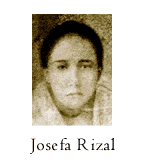Filipino
Women Revolutionaries
Like
ethnicity, gender played a significant role during the Revolution.
As early as 1892, the Katipunan had a women’s chapter,
Katipuneras, which was mostly made up of the wives, mothers,
sisters, and daughters of the Katipuneros. While the Katipuneros
men held clandestine meetings in the interior or back of
a house, the Katipuneras provided the diversionary tactics
in the living room for passers-by to see. Some of these
Katipuneras were Gregoria
de Jesus, Andres Bonifacio’s wife, who became known
as the Lakambini or First Lady of the Katipunan;
Jose Rizal’s sisters; and Melchora
Aquino who was also called Tandang Sora (Old Sora).
Tandang Sora became a legend because she was a medicine
woman who stitched the wounded and cured the sick. Her home
was used by the Katipunan for their clandestine meetings
and she served the Revolution by rendering her "medical"
expertise to Katipunan members.
 There
were also numerous Filipinas who distinguished themselves
in the battlefield. In 1896, Gregoria
Montoya y Patricio, upon the death of her Katipunero
husband, led the charge of a thirty men unit while holding
a Katipunan flag on one hand and a sharp-bladed bolo
(machete) on another hand. She used a white piece of cloth,
commonly used during mass, to ward off bullets. Another
Filipina revolutionary was Agueda
Kahabagan who fought the Spaniards armed with a rifle,
brandishing a bolo and dressed in white. Teresa Magbanua, on the other hand, earned the
sobriquet "Joan of Arc" of the Visayas for the
valor she displayed in many battles.
There
were also numerous Filipinas who distinguished themselves
in the battlefield. In 1896, Gregoria
Montoya y Patricio, upon the death of her Katipunero
husband, led the charge of a thirty men unit while holding
a Katipunan flag on one hand and a sharp-bladed bolo
(machete) on another hand. She used a white piece of cloth,
commonly used during mass, to ward off bullets. Another
Filipina revolutionary was Agueda
Kahabagan who fought the Spaniards armed with a rifle,
brandishing a bolo and dressed in white. Teresa Magbanua, on the other hand, earned the
sobriquet "Joan of Arc" of the Visayas for the
valor she displayed in many battles.
But
Filipino women’s participation during the Revolution
was not confined to actual fighting. Rosario Lopez, a scion
of the wealthy hacendero Lopez clan of Negros, donated
firearms to the revolutionary cause. Similarly, women of
Cavite utilized their business connections to form a network
of contacts for the Revolution. The Filipino Red Cross,
established in 1863, became another venue for women participation
in the Revolution. In 1899, the Red Cross, under the leadership
of the wife of Emilio Aguinaldo, had thirteen chapters spread
out from Ilocos Norte to Batangas. Conventional female activities
such as sewing and cooking were utilized outside the homes
to serve the needs of Filipino troops.

